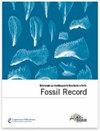白垩纪神秘双翼草蛉新科(神经翅目)
IF 2.1
4区 地球科学
Q3 Earth and Planetary Sciences
引用次数: 20
摘要
草蛉(神经翅目)通常有四个发育良好的翅膀。在几个现存的科中发现了一些短翼类、微翼类或无翼类;这种机翼减少通常与无法飞行有关。唯一有记录的后翼减少(变成小的颈绳状结构)的神经翼类化石是新泽西州晚白垩纪琥珀中神秘的微小属Mantispidiptera Grimaldi。本文报道了中国早白垩世义县组一新属和新种(Dipteromantispa brevisubcosta n. gen. et n. sp.),与螳螂目相似。我们把这两个属归入双翅蛛科,n. fam。它们有发育良好的前翅,脉脉减少,后翅被极大地修饰成小的结构,类似于双翅目的肢节。双翅蛛科;可能是早期蛛科的特化后代,也可能是茎类蛛科+蛛科的特化后代。我们推测双翅蛛是活跃的飞行者。这是神经翼类和双翅目动物翅膀结构平行进化的一个显著例子。(©2013 WILEY-VCH Verlag GmbH &KGaA公司,Weinheim)本文章由计算机程序翻译,如有差异,请以英文原文为准。
A new Cretaceous family of enigmatic two-winged lacewings (Neuroptera)
Lacewings (Neuroptera) normally bear four well-developed wings. There are a few brachypterous, micropterous or apterous species, found in several extant families; this wing reduction is usually associated with flightlessness. The only documented fossil neuropteran with reduced hind wings (modified to small haltere-like structures) is the enigmatic minute genus Mantispidiptera Grimaldi from the Late Cretaceous amber of New Jersey. In this paper, we report a new genus and species from the Early Cretaceous Yixian Formation of China (Dipteromantispa brevisubcosta n. gen. et n. sp.) resembling Mantispidiptera. We place these two genera in the new family Dipteromantispidae, n. fam. They bear well-developed forewings with reduced venation, and hind wings that are extremely modified as small structures resembling the halteres of Diptera. Dipteromantispidae n. fam. might be specialized descendants of some early Berothidae or of stem group Mantispidae þ Berothidae. We presume that dipteromantispids were active fliers. This is a remarkable example of parallel evolution of wing structures in this neuropteran family and Diptera.
求助全文
通过发布文献求助,成功后即可免费获取论文全文。
去求助
来源期刊

Fossil Record
PALEONTOLOGY-
CiteScore
2.50
自引率
7.10%
发文量
18
审稿时长
>12 weeks
期刊介绍:
Fossil Record (FR) is the palaeontological journal of the Museum für Naturkunde Berlin. This journal was founded in 1998 under the name Mitteilungen aus dem Museum für Naturkunde Berlin, Geowissenschaftliche Reihe and appears with two issues each year. Fossil Record publishes original papers in all areas of palaeontology including the taxonomy and systematics of fossil organisms, biostratigraphy, palaeoecology, and evolution. All taxonomic groups are treated, including invertebrates, microfossils, plants, and vertebrates.
 求助内容:
求助内容: 应助结果提醒方式:
应助结果提醒方式:


